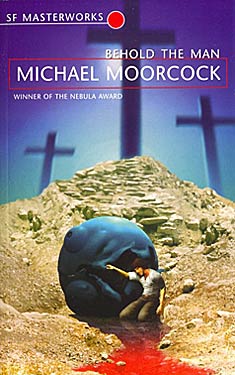Michael Moorcock
Completed 2/16/2014, Reviewed 2/23/2014
4 stars
More than twenty-five years before Gore Vidal sent film
crews and celebrities to make a media event of the crucifixion of Jesus,
Michael Moorcock sent Karl Glogauer back in a time machine to see the
crucifixion for himself. While not as
humorously irreverent as Gore, Moorcock takes a skewed look at the foundation of
Christianity through the eyes of an obsessed agnostic. The novel is an expanded form of the Nebula
winning novella published in 1966.
Beaten by camp counselors, molested by a choir director,
bullied by classmates, failed at love, and questioning religion, Glogauer is
very much a character straight out of many modern classic novels of the ‘60s
and ‘70s. Think about crossing Updike
and Roth, set it in urban England ,
and then speculate about time travel.
Obsessed with crucifixion and crosses since he was a young boy, Glogauer
jumps at the chance to travel back in time. to meet the historical Jesus and
witness the crucifixion. Initially, he
finds himself among John the Baptist and the Essenes, a community of Jews
living austerely, according to the Torah, and awaiting the Messiah. After some time, he goes in search of Jesus,
only to become a surrogate savior.
I really liked Glogauer.
He’s not a great man. In fact,
he’s quite pathetic. He’s flawed in many
ways, especially in his relationships with women. But in the space of this extremely short
novel, Moorcock draws a complete character.
I really liked the form of the novel, too. It jumps between significant points in
Glogauer’s life and his experiences in first century Israel . Interspersed with screams of pain and
anguish, it sets the tone for the novel, the character, and the obvious outcome
of his adventure.
One aspect I really enjoyed was that Glogauer spent time
living among the Essenes. It called to
mind two different thoughts. First, the
book was published at a time when interest in the Dead Sea Scrolls was very
high. Some of the contents of the
scrolls included the Community Rule, rules of living with the Essenes. Moorcock’s placing of Glogauer among the
Essenes gives us a little insight into what was known of them in the mid ‘60s. Moorcock could have gone into a lot more
detail here and I would have been thrilled.
Instead, you get an just an amuse bouche of the ancient desert
community.
The second point of interest is that there was (and may
still be) a train of thought that John the Baptist was an Essene and Jesus
lived among them as well, before beginning his public ministry. Moorcock uses this scenario to ease the
reader into believing that Glogauer could simply slide into the role of not-so-reluctant Messiah after a few years in an ascetic community. In case you’re wondering, Glogauer also
happened to be a student of psychology and ancient languages, which makes a
solo trip to the past a little more believable.
This is not for the religiously squeamish. The revelations about the Jesus and his
family are sure to offend. But I think
the message of the book is that the specific details of the beginning of
Christianity are not significant. The fact
is that this was a messianic, apocalyptic time which was ripe for a new
religion regardless of what really happened and who it happened to. And this was going to screw up people for the
next two thousand years.
This is a four star book.
It’s immediate, engrossing, and thought-provoking. I actually wished it was longer. There could
have been a lot more exploration of the past and a lot more details of
Glogauer’s relationships, obsessions, and pathos. But what you get is worth the short ride.

No comments:
Post a Comment